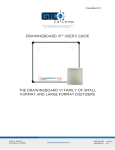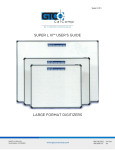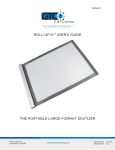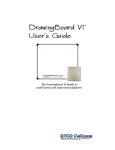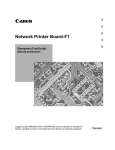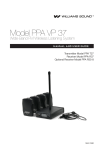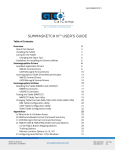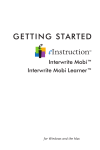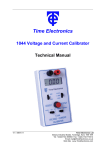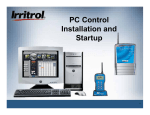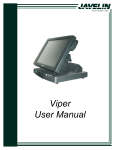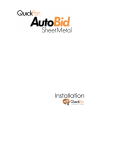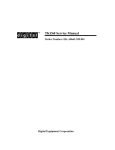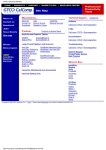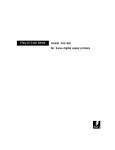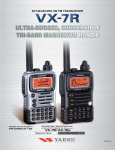Download Super L VI 1 - GTCO CalComp
Transcript
Super L VI 1 Super L VI 2 Table of Contents Introduction Parts Checklist What You Will Need to Use Super L VI PC Requirements For a USB Installation For an Optional Serial Installation Super L VI Overview Active Area SuperSet Menu Indicator Light Transducer Setting Up Your Super L VI Preparing the Super L VI Mounting on the Stand Attaching the Optional Accessory Tray or Plan Holder Software Configuration Configuring Non-Wintab Applications Installing the TabletWorks Driver Hardware Configuration USB Connection QuikRuler III Transducer Connection Optional RS-232 Serial Connection Tablet Power On Using the SuperSet Menu Resetting the Super L VI Turning the Alarm Off and On Testing the Active Area Configuring Your Super L VI for Specific Applications Example: Configuring for a Specific Application Table 1: SuperSet Menu Codes for Selected Applications Table 2: Configuration Details for SuperSet Menu Codes Super L VI Tones Table 3: Super L VI Tones Introduction to the Tablet Configuration Utilities Communication Options 4 5 6 6 6 6 7 7 7 7 8 8 8 8 9 9 9 10 10 11 11 12 12 12 13 14 14 14 15 15 16 26 31 31 32 32 Super L VI 3 Output Format Options Mode Options Using the Tablet Configuration Utilities Learning the Basics Using the Transducer Using the Cursor Using the Pen Learning Basic Movements Clicking and Double-Clicking Dragging Caring for the Tablet and Transducer Cleaning the Tablet Cleaning the Cursor Replacing the Pen Tip Replacing the Cordless Pen Batteries Replacing the Cordless Cursor Batteries Troubleshooting Reducing Monitor Interference Changing the Frequency of the Cordless Cursor Changing the Frequency of the Cordless Pen Tablet Checklist Computer Checklist Software Checklist Does the tablet work with some software? Did the software work in the past? Troubleshooting Chart Procedure A: Begin Troubleshooting Procedure B: Troubleshooting Returning your Tablet for Repair Repacking for Shipment Regulatory Statements and Warranty Radio and Television Interference Canada Declaration of Conformity Japan European Union Emission Directive European Union WEEE Directive Bescheinigung des Herstellers/Importeurs 32 33 34 36 36 36 36 37 37 37 37 37 38 38 38 39 40 41 41 41 42 42 42 42 43 43 45 46 47 47 47 47 48 49 50 50 50 51 Super L VI 4 Limited Warranty for the Super L VI 52 Introduction Super L VI belongs to a class of computer input devices called graphics tablets, or digitizers. A digitizer is an electronic tablet work surface. The position of a transducer, a handheld cursor or stylus pen, on the work surface of the Super L VI is converted – digitized – into data for computer processing. Data output from the Super L VI digitizer is in the form of an X/Y coordinate pair that pinpoints the precise location of the transducer on the tablet surface. By placing a drawing or sketch on the tablet’s surface and tracing over it, graphical information can be easily converted into accurate digital information for entry into the computer. Super L VI digitizers are the next generation of the Super L family of digitizers that set the standard in large-format digitizing. These high performance tools are engineered with a state-of-the-art positioning grid to ensure reliability and quality. Professionals in construction, estimating, CAD, textiles and other fields appreciate the flexibility and performance of the Super L VI series. The Super L VI family of large-format digitizers boasts resolutions of up to 2540 lines per inch, accuracy of 0.010 inch and a wide range of sizes, providing the perfect solution when the work demands precision data input over a large surface area. A variety of cordless and corded cursors and stylus pens are available to use with the Super L VI. An integrated mounting channel allows accessories, such as a plan holder, to be quickly and easily mounted. The high-productivity Super L VI can be used as both a digitizer and a mouse, eliminating the need for multiple devices at your computer. Super L VI works with many graphic, CAD and estimation applications. These applications use the digitized data from Super L VI to: Determine the dimensions of objects on drawings and blueprints Move the pointer on the display screen Create and manipulate objects in a graphic composition Trace a drawing or other source material, to create an image on the screen Select commands or functions from an application menu placed on the tablet surface Select items from a pull-down menu on the screen In order to send data from Super L VI to your digitizing application, the digitizer must be physically connected to your computer, and it must be able to transmit the data in such a way that the digitizing application recognizes and understands it. Super L VI 5 Before setting up Super L VI, you should determine: The requirements of the digitizing software application you’re using Whether your digitizing application requires software drivers to communicate with Super L VI The hardware communications connection (USB or Serial) you will be using between the Super L VI and the computer When the Super L VI is set up for a serial connection, it must be configured so that it can send data in a way the application software will recognize and understand. Different applications have different requirements when interacting with a digitizer. The Super L VI has been designed to provide the appropriate serial requirements for a wide variety of graphic, CAD and estimating applications using a simple code system. The SuperSet Menu located at the top of the Super L VI is used to enter the appropriate code for the software you are using. Table 1 in the Using the SuperSet Menu section of this manual lists the SuperSet Codes for a wide variety of applications. All you have to do is input the code for the application you are using and the Super L VI will be able to communicate properly with the application software on your computer. Table 2 lists the configuration details for each SuperSet Code in Table 1. If for some reason, the communication requirements for your software cannot be found in the two tables provided in the SuperSet Menu section, the Tablet Configuration Utilities on the enclosed GTCO CalComp by Turning Technologies CD can be used to configure your Super L VI so it has the appropriate information it needs to communicate successfully with your software. Parts Checklist Super L VI digitizing tablet Transducer (corded or cordless pen, 4-button or 16-button cursor) USB cable CD-ROM with Windows Drivers and user’s manual Registration card Optional Equipment RS-232 with 9-pin connector for serial connection Power supply – required only for a serial installation Universal mounting brackets Adjustable table feet Accessory tray Plan holder Super L VI 6 What You Will Need to Use the Super L VI Super L VI is equipped with both a USB interface and an RS-232 serial interface, which requires an optional RS-232 cable and power supply. It is compatible with most industrystandard PCs. The TabletWorks CD contains drivers provided by GTCO CalComp by Turning Technologies and is the only software described in this manual. TabletWorks supports reduced functionality Wintab and TabCon-compatible applications. If you are not sure which drivers are required, please consult with your application vendor. A USB connection requires the use of a TabletWorks driver, while a serial connection requires the use of a TabletWorks driver and/or a custom application program. After installing the TabletWorks software, the Super L VI will work with all Windows-based applications as a mouse, in addition to working as a digitizer with Windows-based applications that are specifically designed for use with digitizers. PC Requirements For a USB Installation Microsoft Windows 98 SE, ME, 2000, XP, Vista, 7 or 8 One available USB port 10 MB of free disk space Application software that accepts digitizer input via the Wintab API or TabCon API For an Optional Serial Installation Microsoft Windows 98, ME, NT 4.0, 2000, XP, Vista, 7 or 8 One available RS-232C serial communication port (Serial signal levels must conform to EIA RS-232C specifications.) 10 MB of free disk space Application software that directly accepts digitizer input via the computer’s RS-232C serial port, or via the Wintab API or TabCon API Super L VI 7 Overview The Super L VI consists of: Active Area The drawing area – the Active Area – is the portion of the tablet surface designated for digitizing. Its boundaries are marked at each corner by a right-angle crop mark. SuperSet Menu The SuperSet Menu is the row of keys located across the top of the digitizer. It provides a means of configuring your tablet so that it sends the appropriate information for a serial connection to the software you’re using on your computer. Indicator Light The power/proximity LED in the upper right corner of the Super L VI frame is the Indicator Light. It remains off when the power is on. However, when the transducer is in prox (within the range) of the Active Area, the LED is solid green. Super L VI 8 Transducer Two types of transducers can be used with the Super L VI: pens and cursors. Both are available in corded and cordless versions. The corded transducers get their power from the digitizer. Cordless transducers are powered by batteries. They will go into a batterysaving Sleep Mode when no button has been pressed for one to five minutes, depending on the type of transducer being used. To reactivate a sleeping transducer, press one of its buttons. Cursors The cursor is similar in appearance to a mouse, except that it has an attached lens with crosshairs for highly accurate detail work. Cursors are available in 4 or 16 button models. Pens Each pen is similar in appearance to a ballpoint pen. The pen transducer has three buttons, two on the side of the barrel and one in the pen tip. Two different types of pens, identified by a colored ring on the pen barrel, are available for use with the Super L VI. The cordless Click Tip pen has a light blue ring and the cordless Lite Touch Tip pen, a red ring. Setting Up Your Super L VI The instructions below describe how to set up your Super L VI. Before you begin, please take a moment to fill out and mail the Warranty Registration Card or register your digitizer on our website at http://www.gtcocalcomp.com/warranty-information. Preparing the Super L VI Mounting on the Stand Place the Super L VI on a table, desk or drafting table. You can also mount Super L VI on a stand or pedestal. The tablet’s Universal Mounting Brackets attach directly to those stands that have tilt arms. Stands with tilt pads require right-angle mounting brackets, which are attached to the tilt pads. The tablet’s Universal Mounting Brackets are then attached to the right-angle mounting brackets. Center the tablet over the attached Universal Mounting Brackets and screw the Thumbscrews into the T-Nuts in the mounting channel in the tablet’s frame. Super L VI 9 Attaching the Optional Accessory Tray, Plan Holder or Table Feet Additional T-Nuts have been included in the perimeter mounting channels on the Super L VI frame. You can position the Plan Holder, Table Feet or Accessory Tray where it is most convenient for you by attaching it to any one of the available T-Nuts. The following instructions and the graphic below detail the installation of the Accessory Tray. Simply slide the Tray Rails into the channel and line up the hole in the tray with the hole in the T-Nut. Tighten the Thumb Screw to secure the Accessory Tray. Software Configuration Software drivers provide the communication bridge between your digitizing software application and Super L VI. You should install only the drivers necessary for the Super L VI to work with your application software. If you are not sure which drivers are required, consult with your application vendor. Configuring Non-Wintab Applications Many application programs provide configuration information for specific digitizers. If the Super L VI digitizer is not listed, you can use the configuration for the GTCO CalComp by Turning Technologies Digi-Pad Type 5 or Type 5A (T5/T5A), Roll-Up II, CalComp 3400, DrawingBoard or Summagraphics Microgrid III. Super L VI 10 Installing the TabletWorks Driver Insert the CD into the CD-ROM drive on your computer. The installer will autoload. If it does not, click on the Start button on the Windows Task Bar and select Run from the menu. Type X:\setup.exe (X represents the CD drive letter). Follow the onscreen prompts to complete the installation. A TabletWorks icon will display in the System Tray on the Windows Task Bar. Right click on the icon to display the TabletWorks Menu, which provides access to all the TabletWorks features. Hardware Configuration When you use the USB interface, no hardware configuration is required. When the optional serial interface is selected, Super L VI must be configured to send data in a format that is compatible with the application software. Different applications have different requirements when interacting with a digitizer. The Super L VI is designed to provide the appropriate serial requirements for a wide variety of graphic, CAD and estimating applications using a simple code system. The SuperSet Menu on the surface of the Super L VI is used to enter the appropriate code for the software being used. A table in the Using the SuperSet Menu section of this manual lists the SuperSet Codes for a wide variety of applications. Determine if you have not already, which communication connection you will be using – USB or the optional serial. Super L VI 11 USB Connection Super L VI USB port connection is USB 1.1 and 2.0 compatible. When the digitizer is connected to the USB port, Windows will recognize that there is a new device connected. If Windows displays the Found New Hardware prompt, follow the onscreen instructions to complete the driver installation. 1. Connect the interface cable to the USB jack on the Super L VI Connector Panel. The connector is keyed and will fit only the correct jack. Do not force it. Attach the other end of the USB cable to any one of the USB ports on your computer or USB hub. 2. Turn the power switch on. The green Indicator Light will begin blinking and the digitizer will beep four short tones, indicating it has power. See the Super L VI Tones section for a complete table of the Super L VI tones. NOTE: Power is supplied through the USB port. No additional power source is needed for this installation. QuikRuler III™ Connection The Super L VI has a connection socket for the QuikRuler III. The QuikRuler III is a portable measuring system that quickly and accurately automates blueprint takeoff and drawing measurement processes. Contact GTCO CalComp by Turning Technologies for price and availability. Super L VI 12 Transducer Connection 1. If you are using a corded transducer, connect the cursor or pen to the appropriate jack on the digitizer’s Connector Panel. The connector is keyed and will fit only the correct jack. Do not force it. Optional RS-232 Serial Connection 1. Connect the RS-232 serial cable to the serial jack on the Connector Panel. The connector is keyed and will fit only the correct jack. Do not force it. Attach the 9-pin connector of the serial cable to the serial port on your computer. 2. Plug the power supply into an AC outlet. Connect the power supply to the appropriate jack on the Super L VI Connector Panel. Turn the power switch on. The green Indicator Light will begin blinking and the digitizer will beep four short tones (see the Super L VI Tones section for a complete table of Super L VI tones), indicating it has power. Tablet Power On The Super L VI power switch is located at the rear of the tablet on the Connector Panel. When turned on, the Super L VI’s Indicator Light will begin blinking and four Success tones will sound. If you are using a cordless transducer, turn it on by pressing any button on the tool. The Indicator Light will glow steadily when the transducer is inside the Active Area of the tablet. When the transducer moves outside the Active Area, the Indicator Light will go off. Super L VI 13 Using the SuperSet Menu (RS-232 Only) The SuperSet Menu is the row of buttons printed across the top of the digitizer. It allows you to configure Super L VI to send the appropriate information through an RS-232 serial connection to the software being used on the computer. The SuperSet Menu is used to prepare the digitizer to receive specific, detailed custom configuration information from the Tablet Configuration Utilities for some serial installations. Use your transducer (pen or cursor) to click on the menu buttons to make your selections. In addition, for both serial and USB connections, the SuperSet Menu can be used to reset the Super L VI, turn the digitizer alarm OFF or ON, and test the grid or Active Area. The menu button initiates Select Mode. Two-digit numeric codes are entered after Select Mode is activated. NOTE: The Select Mode will not work with the USB interface. USB digitizers are used exclusively with Wintab drivers. Most software supports Wintab using the TabletWorks drivers, whose SuperSet Code is on the SuperSet Menu. The Super L VI comes from the factory with the SuperSet Code pre-configured. The button toggles the digitizer alarm OFF or ON. The grid in the Active Area. button tests the digitizer When using the SuperSet Menu, a tone will sound indicating a successful selection when you click on the button. Four tones will sound when you select the button. (See the Super L VI Tones section for a complete table of the Super L VI tones.) The number Super L VI 14 buttons through Select Mode. are active only after clicking on the button to activate Resetting Super L VI The Super L VI can be reset by: Turning off the power switch on the Controller Connector Panel Unplugging and re-plugging the power supply Clicking on the SuperSet Menu. When one of these events occurs, the Super L VI will revert to the configuration that was last defined. Any remote commands that were active before the reset will be lost. Turning the Alarm Off and On You can disable the alarm if you do not want to hear a tone each time the transducer button is pressed. When the alarm is off, you will still hear diagnostic and menu-related tones. To turn the alarm Off or On: Click on the button to toggle the tones Off or On. Testing the Active Area To test the Super L VI grid, or Active Area: 1. Using the transducer, click on the button to activate the test. 2. Move the transducer around in the Active Area. If there is a break in the grid or the transducer is out of prox, the tablet will beep. 3. Click the button again to end the test. NOTE: The following is relevant only when connecting via an RS-232 serial installation. USB does not require configuration. Super L VI 15 Configuring Super L VI for Specific Applications To configure your Super L VI for use with specific applications: 1. In Table 1, find the application program you will be using with your Super L VI. Note the corresponding SuperSet Code. If your application program is not listed in Table 1, find the configuration settings in Table 2 that your application program requires and use the corresponding SuperSet Code. If an appropriate SuperSet Code is not listed in Table 2, then use the Tablet Configuration Utilities to configure your Super L VI. 2. On the SuperSet Menu, click on the button, and then click on the two digits of the SuperSet Code indicated for your application. You will hear four short tones after a successful menu configuration. Example: Configuring for a Specific Application To configure your Super L VI to operate with Autodesk’s AutoCAD application, you would: 1. Find the entry for AutoCAD in Table 1. The SuperSet Code is . 2. Click on the button on the SuperSet Menu. You will hear one short tone, indicating the digitizer is in Select Mode. 3. Click on the button on the SuperSet Menu. You will hear one short tone. This enters the first digit of the SuperSet Code for AutoCAD. 4. Click on the button on the SuperSet Menu. This enters the second digit of the SuperSet Code for AutoCAD. You will hear four short tones, indicating that the configuration is complete. The Super L VI is now configured to operate with AutoCAD. Select Mode is no longer active and you can begin digitizing. NOTE: For more information about digitizer software application driver requirements, please visit the Technical Support section of the GTCO CalComp by Turning Technologies website. Super L VI 16 Table 1: SuperSet Menu Codes for Selected Applications Super L VI 17 Super L VI 18 Super L VI 19 Super L VI 20 Super L VI 21 Super L VI 22 Super L VI 23 Super L VI 24 Super L VI 25 Super L VI 26 Table 2: Configuration Details for SuperSet Menu Codes NOTE: Max = 100 coordinates/second lpi = lines per inch lpmm = lines per millimeter Super L VI 27 Super L VI 28 Super L VI 29 Super L VI 30 Super L VI 31 Super L VI Tones The Super L VI produces an alarm in the form of audio tones to inform you of various events. The table below describes the kinds of tones you might hear while operating the digitizer. Table 3: Super L VI Tones *Configuration error tones or Diagnostics failed tones indicate a serious problem. If you hear either of these tones, call GTCO CalComp by Turning Technologies Technical Support at 1.866.746.3015. NOTE: You might hear tones produced by the Super L VI which are actually sent by your application program. (Programs can send commands to the digitizer to turn the audio tone generator on and off.) If you hear tones during digitizing and they do not correspond to the tones listed in the table above, they are produced by the application program. Introduction to the Tablet Configuration Utilities The Super L VI with its Controller uses the Tablet Configuration Utilities to control baud rate, data format and other operating characteristics for the RS-232 interface. It is used to relay configuration information to the Super L VI in cases where Table 1 and Table 2 do not supply the information or a SuperSet Menu Code for the graphic application software being used. Super L VI 32 The configuration parameters for the Super L VI are divided into three categories: Communication Options Output Format Options Mode Options Communication Options Baud: The rate, in bits/second, at which characters are transmitted across the RS232C serial interface. Choices are: 1200, 2400, 4800, 9600, 19200 or 38400. Data Bits: Data bits represent the actual data being sent from one device to another. Both devices must be set for the same number of data bits. Choices are: Seven (7) or Eight (8). Stop Bits: Each character has one or two stop bits, which tell the receiving device that a character is complete. The number of stop bits usually does not matter. Setting for two stop bits instead of one may overcome a mismatch in parity or data bits. Choices are: One (1) or Two (2). Parity: One bit can be allocated for parity (parity is a simple error-detecting scheme). Both devices (sending and receiving) must be set for the same parity – either odd parity or even parity – or they must be set for no parity. Choices are: None (N), Even (E) or Odd (O). Output Format Options GTCO: Selects GTCO-compatible formats. See Advanced Programing Information in the Super L VI Online Help for greater detail on GTCO format structure. Choices are: Binary or ASCII. CalComp: Selects CalComp-compatible formats. See Advanced Programming Information in the Super L VI Online Help for greater detail on CalComp format structure. Choices are: Binary, ASCII 1, ASCII 2, ASCII 3 or ASCII 4. Summa: Selects Summagraphics-compatible formats. See Advanced Programming Information in the Super L VI Online Help for greater detail on Summagraphic format structure. Choices are: Binary or ASCII. Super L VI 33 ASCII formats can be modified by including or excluding a button code, decimal point, carriage return or line feed, depending on whether GTCO, CalComp or Summa formats have been selected. Button: Defines whether the Pushbutton (Pb) value is included in the ASCII output report. This option is available only with GTCO formats. Choices are: Include or Exclude. Space: Defines whether the Space (Sp) character (hex 20) is included in the ASCII output report as a delimiter between the X and Y coordinate values. This option is available only in GTCO formats. Choices are: Include or Exclude. Decimal: Defines whether the period character (hex 2E) is included in the ASCII output report between the units and tenths digits. This option is available only in Summagraphics formats. Choices are: Include or Exclude. Return: Defines whether the Carriage Return (CR) character (hex 0D) is included in the ASCII output report as a terminator. This option is available in GTCO and Summagraphics formats. Choices are: Include or Exclude. Line Feed: Defines whether the Line Feed (LF) character (hex 0A) is included in the ASCII output report as a terminator. This option is available in GTCO, CalComp and Summagraphics formats. Choices are: Include or Exclude. Mode Options Mode: Defines how output reports are sent from the digitizer. Choices are: Point, Line, Continuous, Line Incremental or Continuous Incremental. Rate: Determines how fast output reports will be transmitted from the digitizer. Choices are: 12, 50 or 100 reports per second. Resolution: The smallest reported value returned by the digitizer. Choices are: 1000 lpi, 2000 lpi, 4000 lpi, 40 lpmm, 100 lpmm or 150 lpmm. See the Advanced Programming Information section in the Super L VI Online Help at www.gtcocalcomp.com for more details. Super L VI 34 Using the Tablet Configuration Utilities If your application is not represented in the SuperSet Menu and does not have a SuperSet Code or if a different configuration is required, you can use the Tablet Configuration Utilities to structure the Super L VI. The Tablet Configuration Utilities replace the 24 switches that were associated with older GTCO CalComp by Turning Technologies digitizers and the Custom Configuration Menu Card used with the Super L II Plus. To Configure the Super L VI with the Tablet Configuration Utilities: 1. Make sure the Super L VI is plugged into a Serial Port, powered on and all the tablet drivers have been uninstalled or disabled. 2. Install the Tablet Configuration Utilities from the Select Utility Software to Install section on the TabletWorks CD, or download them from www.gtcocalcomp.com. 3. After installation is complete, run the Tablet Configuration Utilities from the Programs list under GTCO CalComp by Turning Technologies TCU. 4. The Tablet Configuration Utilities will begin searching the Serial Ports for a supported tablet. a. If the tablet is found, information about the tablet will display under Device Info near the bottom of the screen. b. If the tablet is not found, a message will appear under Device Info near the bottom of the screen. i. If Wintab files were found, it is possible that the TabletWorks driver has the Serial Port open. ii. If the Serial Port is open by another application, it will not be displayed under System Info. Close any application or uninstall any driver that is using the Serial Port and select Refresh System Info from the File dropdown list at the top of the screen. Click on the Serial Port icon under System Info to search that Serial Port. NOTE: The Tablet Configuration Utilities can use the TabletWorks driver to test the tablet, but it must be communicating directly with the tablet, via the Serial Port, in order to configure it. 5. Once the Super L VI has been found on a Serial Port, select Advanced Configuration from the Options dropdown list at the top of the screen. a. If Advanced Configuration is not an option, make sure Wintab Compatible Driver is not listed under Device Info. Super L VI 35 6. Select a predefined User Defined through through , SuperSet Code, or select one of the , SuperSet Codes to customize. a. User Defined ( through ) SuperSet Codes are initially read from the tablet when the Advanced Configuration screen opens. This is to prevent loss of custom settings. Selecting Read Current Settings from the Options menu will: i. Read the Power-Up settings and User Defined SuperSet Codes from the tablet. ii. Overwrite all Custom Settings not yet saved to the tablet. b. Restore Factory Settings from the Options menu will prompt for: i. Power-Up settings reset to factory default and set current. ii. User Defined SuperSet Codes cleared and reset to factory default. 7. After making your selections, choose one of the following from the File menu at the top of the screen. a. Save Temporary Settings will configure the tablet as shown until the tablet is powered off, reset or another SuperSet Code is selected. i. After saving temporary settings, select File/Exit to test with other applications. This will leave the tablet configured to the temporary settings selected and close the Serial Port, enabling other applications to communicate with the tablet. b. Save Power-Up Settings will configure the tablet as shown. Every time the tablet is powered off and back on or reset, it will restore these settings. c. Save Custom Settings will reconfigure all nine of the tablet’s User Defined SuperSet Codes to the settings specified in the corresponding SuperSet Code dropdown list. i. You can click on the SuperSet Menu buttons on the tablet using the tablet’s cursor to activate these configurations: plus through . 8. When you have finished, select Exit or Close from the File menu. a. Exit will close the Tablet Configuration Utilities. b. Close will exit the Advanced Configuration Screen and return to the Tablet Configuration Utilities window. Super L VI 36 Learning the Basics You will find that using your DrawingBoard VI tablet is as easy or easier, than using a mouse. The DrawingBoard VI transducers are more accurate than a mouse, giving you greater control over your movements. Using the Transducer The transducer does not need to be in contact with the tablet surface in order for the tablet to sense its presence. It can be detected up to ½” above the Active Area. When the transducer is in the zone above the surface of the digitizer, it is referred to as being in prox. The Indicator Light will go from a blinking green light to a solid green light when the transducer is in prox of, or touching, the tablet’s surface. The in prox zone allows you to trace through materials placed on the digitizer’s surface, such as drawing or a book. Before using the transducer, be sure that Sleep Mode is turned off by pressing a button, or in the case of the pen, touching the tip of the tablet’s surface. Using the Cursor When you use the cursor, the intersection point of the crosshairs on the lens identifies the point you are selecting. The crosshairs are etched on the bottom of the lens to increase accuracy. For maximum precision, look through the lens from a position directly over it. Button 0, the yellow button, is used as the pick, or left mouse, button. All other buttons are defined by the TabletWorks software, or through your own software application. Using the Pen There are two variations of pens: the click tip and the lite touch tip. On both pens, the pen tip is Button 0 and is used as the pick, or left mouse, button. The lower side button is Button 1 and the upper side button is Button 2. The functions these buttons provide are defined through the TabletWorks software, or through your own software application. Click Tip Pen The click tip pen is available in both corded and cordless versions. It is primarily used for tracing and menu picking. To use the click pen, press down until you feel the tip click. Super L VI 37 Lite Touch Pen The lite touch pen is available only in the cordless version. It is similar to the click tip pen, except that it calls for, as the name implies, a lighter touch, without the click. Learning Basic Movements Clicking and Double-Clicking Clicking is the action of making a selection. You may be selecting a key on the digitizer surface or making a selection from your computer monitor. To click, place the transducer or move the screen pointer using the transducer, to the item to be selected. Tap the pen or press Button 0 on the cursor. A double-click requires you to quickly tap the pen or press the button two times, while the tool remains in the same place. You can also double-click by pressing the pen or cursor button that has been defined as a double-click button (see TabletWorks Help). Dragging Dragging is the action of moving the transducer during a selection. To drag, click on an object, but instead of lifting the pen tip or releasing the cursor button, hold it down while moving the transducer, or corresponding object on the screen, to the desired new location. Caring for the Tablet and Transducer Follow these precautions at all times to avoid damaging your Super L VI: Avoid discharging static electricity to the tablet. Do not place heavy objects on the tablet surface. Do not use sharp objects; such as compasses or knives, on the tablet surface. Do not use the tablet surface for any purpose other than drawing, tracing or digitizing. Do not drill holes on any part of the digitizer or controller. Cleaning the Tablet To clean the tablet’s surface, use a soft, non-abrasive cloth. Hardened dirt can be removed with a slightly dampened cloth. Do not clean pencil lines with a soft cleanser or pencil eraser. This could create an undesirable shiny spot on the tablet’s surface that cannot be removed. Super L VI 38 Cleaning the Cursor To clean the cursor body, use a mild cleanser. Do not spray the cleanser directly on the cursor – instead, dampen a soft cloth with a mixture of water and the cleanser. Clean the cursor reticles with alcohol. Replacing the Pen Tip To replace the pen tip, grasp the tip and pull straight out (see figure). Insert the new tip and press until it clicks into place. Replacing the Cordless Pen Batteries The pen requires two 393 silver oxide batteries. The average battery life is 200 hours. Super L VI 39 To replace the batteries: 1. Unscrew the pen cap. Hold the pen from the bottom and gently slide off the pen cover to expose the batteries. 2. Remove the old batteries by turning the pen over and gently tapping it, letting the batteries fall into your other hand. 3. Insert the new batteries as they are shown in the figure above (+ towards pen tip). 4. Replace the pen cover and screw the pen cap onto the pen. NOTE: When you replace the pen batteries, the pen will reset to the default frequency. If you changed the frequency of the pen before replacing the batteries, you will need to do so again after replacing the batteries (see the Reducing Monitor Interference section in Troubleshooting). Replacing the Cordless Cursor Batteries The cordless cursor requires two AAA batteries. The average battery life for the cursor batteries is 2,000 hours. Super L VI 40 To replace the batteries: 1. Place the cursor face down in the palm of your hand. Use a Phillips screwdriver to remove the two screws located on the bottom of the cursor (see figure). Remove the cursor base. 2. Remove the old batteries from the battery casings. 3. Place the new batteries in the casings, matching the polarity of each battery with the markings on the connector strips (match + to +). 4. Reposition the cursor base. Replace the screws with the Phillips screwdriver. NOTE: When you replace the cordless cursor batteries, the cursor will reset to the default frequency. If you changed the frequency of the cursor before replacing the batteries, you will need to do so again after replacing the batteries (see the Reducing Monitor Interference section in Troubleshooting). Troubleshooting Guide GTCO CalComp by Turning Technologies wants your experience with Super L VI to be a successful one. If you ever encounter a problem, please follow the steps below: 1. Install properly first. This troubleshooting guide assumes you have already correctly installed your Super L VI according to the detailed instructions in the Installing Your Super L VI section. If you have not followed the step-by-step instructions in that section, do so now. Super L VI 41 2. Read the topics below to check for a solution to your problem. Work through the troubleshooting flowcharts on the following pages in this troubleshooting guide. The Tablet Configuration Utilities application referenced there can be found in Super L VI Online Help. Record any unusual observations. Your notes will be useful if you need assistance from GTCO CalComp by Turning Technologies. 3. If your system still doesn’t work. Call GTCO CalComp by Turning Technologies Technical Support at 1-866-746-3015 (in the U.S. or Canada) or email us at [email protected]. Outside the U.S. or Canada, contact your local GTCO CalComp by Turning Technologies office or dealer. Be prepared to discuss the observations you made while troubleshooting. Reducing Monitor Interference If you are experiencing monitor interference with your tablet, you can reduce the interference by changing the frequency your transducer uses. This can be done only for transducers that support changing the frequency. Transducers with the following FCC ID numbers support two frequencies: ECPPPP, ECPPP2, ECPPLTP, ECPPCURSOR4, ECPPCURSOR16 and ESPPCURSORII. Transducers with FCC ID numbers other than those listed must have their frequency changed by GTCO CalComp by Turning Technologies. Changing the Frequency of the Cordless Cursor 1. Place the cursor on the tablet surface. 2. Press Buttons 1 and 2 simultaneously and hold for approximately three seconds. 3. The cursor turns itself off. You will know the cursor is off when the Indicator Light on the tablet begins blinking. 4. The cursor turns on again at the new frequency. You will know the cursor is on when the Indicator Light glows steadily. To return to the default frequency, repeat the above process. When you replace the cursor batteries, the cursor is automatically reset to the default frequency. Super L VI 42 Changing the Frequency of the Cordless Pen Press both side buttons and the tip simultaneously and hold for approximately three seconds. To return to the default frequency, repeat the above process. When you replace the pen batteries, the pen resets to the default frequency. Tablet Checklist Is the tablet power supply (used only with the serial connection to the computer) plugged into the digitizer and into a live outlet? Is the tablet power switch on? Does the Indicator Light glow steadily when the transducer is in prox inside the Active Area? Does the Indicator LED go out when the transducer is outside the Active Area? The Indicator Light will be off if the transducer has gone into Sleep Mode. Press any button on the transducer to activate it. If the transducer is in the Active Area and the Indicator Light remains off, change the transducer’s battery. Are all cable connections seated properly? Is the communications cable (either USB or serial) connected to both the digitizer and the computer? Check that the cable is connected to the serial port specified in your software package. Is the transducer cable connected to the digitizer? Is the tablet set up according to the software recommendations? Are any of the connector cables or receptacles damaged? Check for bent pins, cut insulation and loose wires. Computer Checklist Is the computer plugged into a live outlet? Did you turn on the computer? Does the computer work with any of your software? Try one of your other programs. If the computer has a diagnostic diskette, use it. Is your software package installed correctly? If your communications connection is USB, does the USB port work? If serial, does the serial port work? The only way to test the port without special equipment is to reinstall something that has worked in the past and see if it still works. Have there been any recent electrical storms in your area that may have damaged your equipment? Super L VI 43 Software Checklist Does the tablet work with some software? If your tablet currently works with some software packages, you know that the tablet, USB or serial port and computer work. Even if the software package you are trying to install and the software that is working both support the same tablets, it does not always mean that you can use the same tablet settings. The output format may be the same, but the communications protocol, resolution, operating mode and data rate may be different. Check your software’s requirements. Call the software manufacturer. Perhaps the software package has a problem with another component of your system. Did the software work in the past? If the software package worked with the tablet in the past, then the problem lies with the new set up. Check all the connectors. Is the tablet still plugged into the same port? If yes, reset the tablet by unplugging and re-plugging the power supply and restart the software. Did you reset or power down the computer? During reset and power on, the computer can send meaningless characters out the serial port and this can disable the tablet. Reset the tablet again. Have you installed any new software or hardware? Remove it from your system and see if the problem goes away. Did you move any cables? If you are using a PC, did the new software alter your AUTOEXEC.BAT file? Have you updated the software or its drivers? Are you loading another mouse driver? Did you reinstall the software, perhaps after a problem with your hard drive? Double check your installation procedure and the driver you selected. Reinstall the software from its master diskettes. The program files may have been corrupted. Super L VI 44 Troubleshooting Chart The following table lists common Super L VI problems, their causes and their solutions. Problem Frozen screen pointer Screen pointer appears to shake or jitter Cause Transducer is in Sleep Mode. Solution Press any button on the transducer. Menu Strip is in Configuration Mode. If the configuration light is on, click on the Config/Exit key on the Menu Strip. Tablet plugged into the wrong serial port on the computer. Is the serial port being used correctly identified in your software application? Tablet not powered correctly. Check that the power cable is installed correctly. Batteries low in transducer. Replace the batteries in the transducer. Software application set up incorrectly. Check that the tablet is identified in your software application. Another device is connected to a COM port that shares the same IRQ as the tablet COM port (i.e., your tablet is connected to COM1 IRQ4 and your modem is connected to COM3 IRQ4). Move one of the devices to another COM port. Contact your system manufacturer for assistance in relocating the device. Tablet is set too close to the screen monitor. Move the tablet farther away from the screen. Tablet’s frequency setting Alternate the transducer’s Super L VI 45 Unable to use the entire tablet surface may conflict with the display. frequency. (See the Reducing Monitor Interference section.) Incorrect format selected. Check your selections in the Menu Strip. Software application set up incorrectly. Check that the tablet is identified in your software application. Procedure A: Begin Troubleshooting NOTE: This procedure should only be used to troubleshoot serial connections. Super L VI 46 Procedure B: Troubleshooting Super L VI 47 Super L VI 48 Returning your Tablet for Repair If you believe you have a defective tablet, first see all topics in this section (above) and visit our website at www.gtcocalcomp.com for the latest support information. If you’re still unable to properly operate your digitizer system, please call Technical Support at 1.866.746.3015 or email us at [email protected]. Technical Support will assist you in determining if your tablet is defective and will help you obtain a Return Merchandise Authorization (RMA) number. Important: Please do not return your product without first discussing the issue with, and receiving an RMA from, a GTCO CalComp by Turning Technologies Technical Support Specialist. Repackaging for Shipment Whenever you ship electronic equipment, try to ship it in its original packing materials. Because packing materials are static-charged, you should ship the cursor or any extra electronics boards inside approved antistatic plastic bags. If you are shipping the tablet or accessories to a GTCO CalComp by Turning Technologies Service Center for repair, attach a tag to the equipment with the following information: Model number Serial number Maintenance contract number (if applicable) Return Merchandise Authorization number Detailed description of the problem Regulatory Statements and Warranty Radio and Television Interference The user is cautioned that any changes or modifications not expressly approved by the party responsible for compliance could void the user’s authority to operate the equipment. This equipment has been tested and found to comply with the limits of a Class B digital device, pursuant to Part 15 of the FCC rules. These limits are designed to provide reasonable protection against harmful interference in a residential installation. This equipment generates, uses and can radiate radio frequency energy and, if not installed and used in accordance with the instructions, may cause harmful interference to radio communications. However, there is no guarantee the interference will not occur in a particular installation. If this equipment does cause harmful interference to radio or Super L VI 49 television reception, which can be determined by turning the equipment off and on, the user is encouraged to try to correct the interference by one or more of the following measures: Reorient or relocate the receiving antenna. Increase the separation between the equipment and the receiver. Connect the equipment into an outlet on a circuit different from that to which the receiver is connected. Reorient or coil cables. Consult the dealer or an experienced Radio/TV technician for help. NOTE: Any cables the user adds to the device must be shielded to be in compliance with the FCC standards. Any unauthorized modification to this device could result in the revocation of the end user’s authority to operate this device. Canada This digital apparatus does not exceed the Class B limits for radio noise emissions from digital apparatus as set out in the radio interference regulations of the Canadian Department of Communications. Le present appareil numérique n’emet pas bruits radioelectriques depassant les limites applicables aux appareils numériques de Classe B prescrites dans le réglement sur le brouillage radioelectrique edicte par le Ministere des Communications du Canada. Super L VI 50 Super L VI 51 Japan European Union Emission Directive This product is in conformity with the protection requirements of EU Council Directive 89/366/ECC on the approximation of the laws of the Member States relating to electromagnetic compatibility. This product has been tested and found to comply with the limits for Class B Information Technology Equipment according to CISPR 22/European Standard EN55022. The limits for Class B equipment were derived for typical industrial environments to provide reasonable protection against interference with licensed communication devices. European Union WEEE Directive The manufacture of this equipment required the extraction and use of natural resources. It may contain hazardous substances that could impact health and the environment. In order to avoid the dissemination of the hazardous substances into the environment and to diminish the pressure on our natural resources, GTCO CalComp by Turning Technologies encourages you to return this product to the appropriate take-back system facility. These facilities reuse or recycle most of the materials in this equipment in a responsible way. The crossed-out wheeled bin symbol below invites you to use these take-back systems. If you need more information about the collection, reuse and recycling systems in your area, please contact your local or regional waste authority. Further information about the responsible end-of-life management of this and other GTCO CalComp by Turning Technologies products is available on our website at www.gtcocalcomp.com. Super L VI 52 Bescheinigung des Herstellers/Importeurs Heirmit wird bescheinigt, dass der/die/das Super L VI (Geraet, Typ, Bezeichnung) im Uebereinstimmung mit den Bestimmungen der Vfg 1046/1984 (Amtsblattverfuegung) Funk-Entstort ist. Der Deutschen Bundespost wurde das Inverkehrbringen dieses Geraetes angezeigt und die Berechtigung zur Ueberpruefung der Serie auf Einhaltung der Bestimmungen eingeraumt. GTCO CalComp by Turning Technologies, Inc. (Name des Herstellers/Importeurs) Dieses Geraet wurde einzeln sowohl als auch in einer Anlage, die einen normalen Anwendungsfall nachbildet, auf die Einhaltung der Funkentstoerbestimmungen geprueft. Es ist jodoch moeglich, dass die Funkentstoerbestimmungen unter unguenstigen Umstaenden bei anderen Geraetekombinationen nicht eingehalten werden. Fuer die Einhaltung der Funk-entstoerbestimmungen seiner gesamten Anlage, in der dieses Geraet betrieben wird, ist der Betrieber verantwortlich. Einhaltung mit betreffenden Bestimmungen kommt darauf an, dass geschirmte Ausfuhrungen gebraucht werden. Fuer die beschaffung richtiger Ausfuhrungen ist der Betrieber verantwirtlich. Super L VI 53 Limited Warranty for Super L VI GTCO CalComp by Turning Technologies, Inc. warrants these products to be free from defects in material and workmanship under the following terms. Complete and return the enclosed warranty registration card to ensure that your products are covered with this warranty. Coverage Parts and labor are warranted for two (2) years from the date of the first consumer purchase for the digitizer tablet, controller, transducers and tablet accessories. Power supply and cables are also warranted for one (1) year. This warranty applies to the original consumer purchaser only. Within the European Union, the warranty period is two (2) years, as mandated by the EU. Contact your local dealer or distributor for additional warranty information. Warranty is only valid if original consumer’s purchase or lease date is less than or equal to six months from the original GTCO CalComp by Turning Technologies sale date. This information will be captured by the system serial number and confirmed by the reseller’s purchase order. A nominal Warranty Handling Fee will be charged after the first 90 days of use and calculated from the date of original consumer purchase. This payment may be made by Visa, MasterCard or American Express. A copy of the sales receipt or invoice will be required for warranty verification. Conditions Except as specified below, this warranty covers all defects in material or workmanship in the products. The following are not covered by the warranty: 1. Any product on which the serial number has been defaced, modified or removed (if applicable). 2. Damage, deterioration or malfunction resulting from: a. Accident, misuse, abuse, neglect, fire, water, lightning or other acts of nature, unauthorized modification for any purpose, unauthorized product modification, or failure to follow instructions supplied with the product. b. Repair or attempted repair by anyone not authorized by GTCO CalComp by Turning Technologies. c. Any damage in shipment of the product (claims must be presented to the carrier). d. Any other cause which does not relate to a manufacturing defect. 3. Any product not sold or leased to a consumer within six months of GTCO CALCOMP BY TURNING TECHNOLOGIES original sale date. GTCO CalComp by Turning Technologies will pay all labor and material expenses for covered items, but will not pay for the following: 1. Removal or installation charges. Super L VI 54 2. Costs for initial technical adjustments (set up), including adjustment of user controls. 3. Certain shipping charges. (Payment of shipping charges is discussed in the next section of this warranty.) 4. Packaging costs. (Customers should keep their boxes.) Warranty Service Procedures 1. To obtain service on your GTCO CalComp by Turning Technologies product, contact the Technical Support Department to receive a Return Material Authorization Number (RMA#) and shipping instructions by calling: 1-866-746-3015. 2. Ship the product to GTCO CalComp by Turning Technologies with the RMA# marked clearly on the outside of the box. Without a clearly marked RMA# on the shipping box, GTCO CalComp by Turning Technologies reserves the right to refuse the shipment. 3. Although you must pay any shipping charges to ship the product to GTCO CalComp by Turning Technologies for warranty service, GTCO CalComp by Turning Technologies will pay the return shipping charges for ground shipment. Other shipping options are available at an additional fee. 4. Whenever warranty service is required, the original dated sales invoice (or a copy) must be presented as proof of warranty coverage and should be included in shipment of the product. Please also include your name, address, telephone number, fax number, email address and a description of the problem. 5. If GTCO CalComp by Turning Technologies determines that the unit is not defective within the terms of the warranty, the consumer shall pay the cost of all freight charges, as well as any repair charges. Technical Support Web-based Technical Support is available free of charge at: www.gtcocalcomp.com, where current driver releases, as well as comprehensive technical support, troubleshooting, Technical Bulletins and FAQs can be found. Telephone Technical Support is available free of charge to the original consumer for a period of 90 days from the date of purchase of the product. Please contact our Technical Support Department at: 1-866-746-3015 or fax your request to: 480.998.1751. Disclaimer of Unstated Warranties The warranty printed above is the only warranty applicable to this purchase. ALL OTHER WARRANTIES, EXPRESS OR IMPLIED, INCLUDING, BUT NOT LIMITED TO, THE IMPLIED WARRANTIES OF MERCHANTABILITY AND FITNESS FOR A PARTICULAR PURPOSE ARE DISCLAIMED. Assuming the warranty above stated is otherwise applicable, it is expressly understood and agreed that GTCO CalComp by Turning Technologies sole liability whether in contract, tort, under any warranty, in negligence or other shall be for the repair or replacement of the defective parts and under no circumstances shall GTCO CalComp by Turning Technologies be liable for special, indirect or consequential damages. The price stated and paid for the equipment is a consideration in limiting GTCO CalComp by Turning Technologies liability. Super L VI 55 Notice Some states and provinces do not allow the exclusion or limitation of incidental or consequential damages, so the above exclusion may not apply to you. This warranty gives you specific legal rights, and you may have other rights, which vary from state to state, or province to province. To obtain service on your GTCO CalComp by Turning Technologies product, call our Technical Support Department at: 1-866-746-3015 or fax us at (480) 998-1751. We can also be contacted through our website at www.gtcocalcomp.com (in US); at [email protected] (in Germany); at [email protected] (in France). Important! All products returned to GTCO CalComp by Turning Technologies for service must have prior approval in the form of a Return Merchandise Authorization Number (RMA#), which can be obtained by calling the Technical Support Department. Super L VI 56 Corporate Headquarters 14557 N. 82nd Street Scottsdale, Arizona 85260 Tel: 1-866-746-3015 Support: 1-866-746-3015 Fax: 480-998-1751 Support: 1.866.746.3015 Copyright© 2014 GTCO CalComp by Turning Technologies, Inc. Super L VI is a trademark of GTCO CalComp by Turning Technologies, Inc. All other products and company names are the trademarks or registered trademarks of their respective owners. The information contained in this document is subject to change without notice. GTCO CalComp by Turning Technologies assumes no responsibility for technical, or editorial errors, or omissions that may appear in this document, or for the use of this material. Nor does GTCO CalComp by Turning Technologies make any commitment to update the information contained in this document. This document contains proprietary information which is protected by copyright. All rights reserved. No part of this document can be photocopied or reproduced in any form without the prior, written consent of GTCO CalComp by Turning Technologies, Inc.
























































